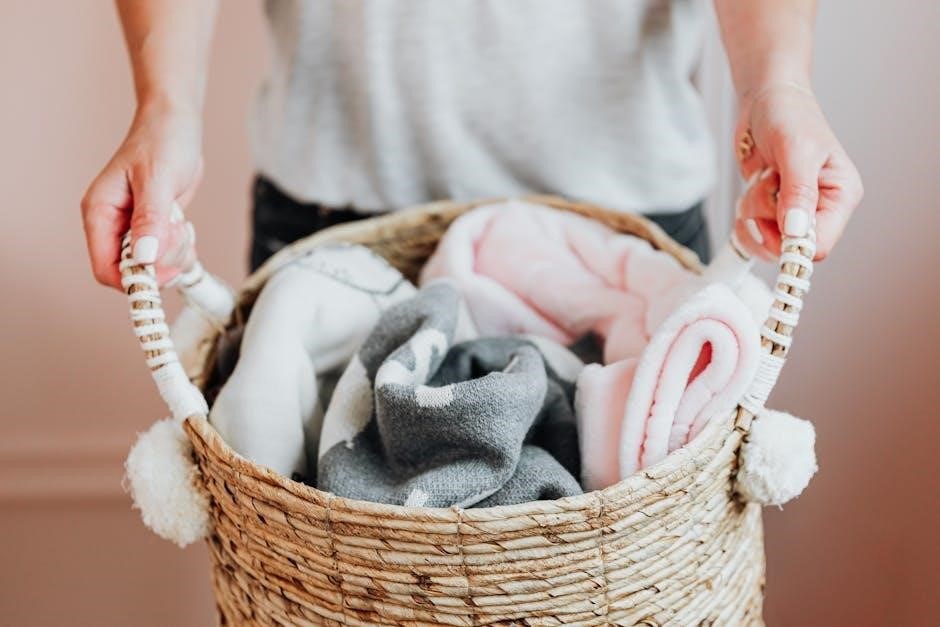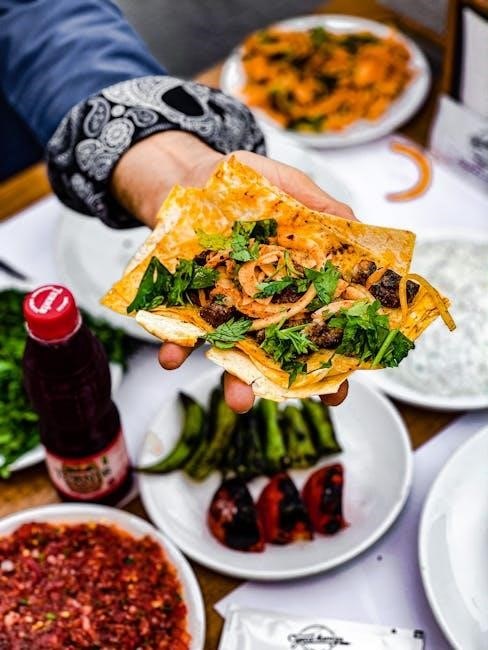Woven wraps are a popular choice for babywearing‚ offering comfort and support․ This guide helps you navigate size selection for the perfect fit․
What Are Woven Wraps?
Woven wraps are long pieces of fabric designed for babywearing‚ offering a comfortable and secure way to carry infants and toddlers․ Made from tightly woven materials‚ they provide optimal support and durability․ Unlike stretchy wraps‚ woven wraps are less prone to sagging and maintain their shape over time․ They are available in various patterns‚ colors‚ and blends‚ making them both functional and stylish․ Woven wraps are adjustable‚ allowing for a customizable fit for both the wearer and the baby․ They are ideal for front‚ back‚ and hip carries‚ making them versatile for different stages of a child’s development and various carrying preferences․
The Importance of Choosing the Right Size

Choosing the right size for a woven wrap is crucial for comfort‚ support‚ and safety; A properly fitting wrap ensures optimal weight distribution‚ preventing discomfort and strain․ A wrap that is too small may not provide adequate coverage or support‚ while one that is too large can be cumbersome and difficult to manage․ The right size allows for a snug‚ secure fit‚ promoting healthy posture for both the wearer and the baby․ Additionally‚ it ensures ease of use‚ making it simpler to achieve a comfortable and safe carrying position․ Proper sizing is essential for maximizing the benefits of babywearing with a woven wrap․
Understanding Woven Wrap Sizes
Woven wrap sizes vary‚ typically ranging from 2 to 7‚ with each size offering different lengths for optimal comfort and support during babywearing․
Standard Size Ranges for Woven Wraps
Woven wraps typically come in sizes ranging from 2 to 7‚ with each size corresponding to a specific length․ Size 2 is the shortest‚ suitable for small adults or newborns‚ while size 7 is the longest‚ accommodating taller wearers or multiple passes․ The most common sizes are 4‚ 5‚ and 6‚ which fit average-sized individuals․ Each size offers a different length to ensure proper coverage and comfort for both the wearer and the baby․ Understanding these standard ranges is essential for selecting the right wrap for your needs․
How Sizes Correlate to Height and Weight
Woven wrap sizes are designed to accommodate various heights and weights‚ ensuring comfort and proper support․ Generally‚ taller individuals or those with a higher body mass may require longer wraps‚ while shorter or petite wearers may prefer shorter sizes․ The correlation between size and height/weight is not absolute‚ as body proportions and carrying styles vary․ However‚ as a guideline‚ sizes 4-6 typically suit average heights and weights‚ while sizes 2-3 or 7-8 cater to smaller or larger frames․ This correlation helps in narrowing down the ideal size for a snug and comfortable fit․
Factors Influencing Wrap Size
Wrap size is influenced by body type‚ baby’s age‚ and intended use․ These factors ensure a comfortable‚ secure fit for both wearer and child․
Body Type and Wrap Size

Your body type significantly impacts the ideal woven wrap size․ Petite individuals may prefer shorter wraps for ease‚ while taller or plus-size wearers might need longer lengths․ Shoulder width‚ hip size‚ and torso length also play a role in achieving a comfortable‚ secure fit․ Proper fit ensures both wearer comfort and baby safety․ Consider your body measurements and how they align with size charts․ Don’t overlook the importance of fabric stretch and drape‚ as these factors can enhance or hinder comfort․ By understanding your body type‚ you can select a wrap size that offers optimal support and flexibility for your unique needs․
Baby’s Age and Developmental Stage
A baby’s age and developmental stage greatly influence the choice of woven wrap size․ Newborns require a snug‚ supportive fit to ensure proper positioning and comfort․ As babies grow and develop‚ their size and strength change‚ necessitating adjustments in wrap size․ Infants typically need smaller wraps‚ while toddlers may require larger sizes for added support․ Consider the baby’s ability to sit up‚ stand‚ or walk‚ as these milestones affect the fit and comfort of the wrap․ Choosing the right size based on age and development ensures a safe and comfortable carrying experience for both baby and wearer․
Intended Use (Front Carry‚ Back Carry‚ etc․)
The intended use of a woven wrap significantly impacts the size selection․ Front carries typically require a standard size for optimal comfort and support․ Back carries may necessitate a longer wrap to ensure the baby is securely positioned and the wearer’s shoulders are not strained․ Hip carries and other variations also influence size choices‚ as they may require more or less fabric depending on the desired snugness․ Considering the primary carrying method helps determine whether a shorter‚ standard‚ or longer wrap is most suitable‚ ensuring both comfort and functionality for the wearer and baby․
How to Measure for a Woven Wrap
Measuring for a woven wrap involves determining your base size by wrapping a tape measure around your natural waistline․ This ensures a snug‚ comfortable fit for both front and back carries‚ allowing for proper support and adjustability․ Always refer to the manufacturer’s sizing guide for accurate measurements‚ as sizes may vary slightly between brands․ Proper measurement is key to selecting the right wrap size for optimal comfort and functionality․
Measuring Your Body for the Perfect Fit
Measuring your body for a woven wrap involves determining your base size‚ which is typically measured around your natural waistline․ Use a flexible tape measure to wrap snugly around the narrowest part of your torso‚ usually just above the hip bones․ Ensure the tape measure is level and not too tight or too loose; This measurement will help you determine your ideal wrap size for a comfortable and secure fit․ For front carries‚ the wrap should fit snugly around your body‚ while back carries may require a slightly different adjustment for optimal support․ Always check the fit after wrapping to ensure proper comfort and coverage․
How to Measure Your Baby
Measuring your baby is essential for determining the appropriate woven wrap size; Start by measuring their height while they are lying down‚ ensuring their legs are fully extended․ Next‚ weigh your baby to understand their size relative to their age․ Consider their developmental stage‚ as younger babies may require a smaller wrap‚ while older babies or toddlers need more fabric for support․ Use these measurements to reference size charts‚ ensuring the wrap fits comfortably around your baby’s body․ This helps achieve a secure and ergonomic carry‚ promoting comfort and proper positioning․ Always check for a snug fit that allows for growth․
Using Size Charts for Accurate Measurement
Size charts are invaluable for determining the right woven wrap size․ Start by accurately measuring both yourself and your baby‚ then compare these measurements to the chart․ Pay attention to how the chart correlates height‚ weight‚ and body type to wrap sizes․ Different brands may have slight variations‚ so always refer to the specific brand’s chart․ Consider both your own and your baby’s measurements to ensure a comfortable fit․ Double-check the chart’s accuracy by cross-referencing multiple sources or seeking advice from babywearing communities․ This ensures a precise fit that accommodates both comfort and growth․ Proper sizing guarantees a secure and enjoyable carry․

Choosing the Right Size for Your Needs
Ensure the woven wrap size aligns with your baby’s age‚ weight‚ and your body type․ Consider intended use—front‚ back‚ or hip carry—and personal comfort preferences․
Size Considerations for Newborns
For newborns‚ choosing the right woven wrap size ensures comfort and safety․ A size 6 or 7 wrap is typically recommended‚ as it provides adequate support without being overly restrictive․ The wrap should allow for a snug fit‚ with the baby held close to the caregiver’s chest․ Measure carefully‚ considering the caregiver’s height and the baby’s length․ A properly fitting wrap will cover the baby’s back and bottom‚ promoting healthy posture․ Opt for a wrap with minimal stretch for newborns‚ as it offers better support during early developmental stages․ Always consult a size chart or seek guidance to ensure the best fit for your newborn․
Size Considerations for Toddlers
When selecting a woven wrap for toddlers‚ consider their size and weight to ensure comfort and support․ A size 7‚ 8‚ or 9 wrap is often ideal‚ as it provides enough length to accommodate their larger frame․ The wrap should allow for a snug‚ secure fit while enabling proper positioning․ Look for a wrap with sturdy fabric to support their weight․ Measure carefully‚ ensuring the wrap is long enough to cover their back and bottom comfortably․ Avoid wraps that are too tight‚ as they may restrict movement․ Proper sizing ensures your toddler stays comfortable and secure during carries‚ promoting a positive experience for both wearer and child․
Size Considerations for Different Carrying Positions
When choosing a woven wrap size‚ consider the carrying position․ Front carries typically require a shorter wrap‚ while back carries may need more length for comfort․ Hip carries often fall between these two․ Opt for a size that allows the wrap to fit snugly around your body and baby‚ ensuring proper positioning․ Adjustable wraps are versatile for multiple positions․ Measure according to the position you’ll use most‚ as this impacts the necessary length․ Proper sizing ensures a secure‚ comfortable fit for both wearer and baby‚ regardless of the carrying method․

Common Mistakes When Selecting a Wrap Size
When choosing a woven wrap size‚ consider the carrying position․ Front carries typically require a shorter wrap‚ while back carries may need more length for comfort․ Hip carries often fall between these two․ Opt for a size that allows the wrap to fit snugly around your body and baby‚ ensuring proper positioning․ Adjustable wraps are versatile for multiple positions․ Measure according to the position you’ll use most‚ as this impacts the necessary length․ Proper sizing ensures a secure‚ comfortable fit for both wearer and baby‚ regardless of the carrying method․
Overestimating or Underestimating Your Size
A common mistake when selecting a woven wrap size is overestimating or underestimating your body size․ Many people guess their size instead of measuring accurately‚ leading to an ill-fitting wrap․ Overestimating may result in a wrap that’s too long‚ causing excess fabric and discomfort․ Underestimating can leave the wrap too short‚ making it difficult to achieve a secure carry․ Body type‚ such as broader shoulders or a longer torso‚ can also affect size needs․ Always use a size chart and measure carefully to avoid these errors․ Proper fit ensures comfort and safety for both wearer and baby‚ making accurate sizing essential․
Not Considering the Baby’s Growth
One major oversight when selecting a woven wrap size is not accounting for the baby’s growth․ Babies develop rapidly‚ and a wrap that fits perfectly in infancy may be too small within months․ Parents often choose a size based on the baby’s current height and weight‚ ignoring future growth spurts․ This leads to a wrap that becomes too tight or impractical as the baby grows․ Considering the baby’s age and developmental stage ensures the wrap remains usable for a longer period․ Opting for a slightly larger size or an adjustable wrap can accommodate growth‚ providing long-term comfort and practicality for both baby and wearer․

Ignoring the Fabric Type and Stretch

Overlooking the fabric type and its stretch can lead to an ill-fitting woven wrap․ Different fabrics‚ such as cotton‚ linen‚ or blends‚ have varying degrees of elasticity and drape․ A wrap that is too stiff may feel uncomfortable‚ while one that is too stretchy might lack proper support․ The stretch of the fabric affects how the wrap molds to the body and holds the baby securely․ Failing to consider this can result in a wrap that either sags or restricts movement․ Matching the fabric’s stretch to the intended use ensures a comfortable and supportive carrying experience for both the wearer and the baby;
Adjusting Your Woven Wrap for the Best Fit
Adjusting your woven wrap ensures a snug‚ comfortable fit․ Properly tighten and loosen the fabric to distribute tension evenly‚ accommodating your baby’s position while maintaining support and safety․
How to Tighten and Loosen the Wrap
To achieve the perfect fit‚ learn how to tighten and loosen your woven wrap effectively․ Start by ensuring the fabric is evenly spread across your shoulders․ Gently pull the ends of the wrap to tighten it‚ making sure there’s no slack․ For loosening‚ carefully lift and adjust the fabric‚ allowing for a comfortable range of motion․ Always check the tightness by sliding your hand between the wrap and your body—it should feel snug but not restrictive․ Practice adjusting the wrap in small increments to find the ideal balance for you and your baby․

Adjusting for Different Carrying Positions
Adjusting your woven wrap for different carrying positions ensures comfort and support․ For front carries‚ focus on snugness around your chest and shoulders‚ ensuring the baby is close to your body․ Back carries may require slightly more fabric for coverage‚ with the wrap tightened securely around your torso․ Hip carries often need a slightly looser adjustment for ease of movement․ Practice adjusting the fabric tension and positioning to accommodate each style‚ ensuring the wrap feels comfortable and secure in every configuration․ This adaptability is key to enjoying your woven wrap in various carrying scenarios․
Using Tutorials and Videos for Guidance
Watching tutorials and videos is an excellent way to master the art of using a woven wrap․ Visual guidance helps clarify complex steps‚ such as tying and adjusting‚ and demonstrates proper techniques for safe and comfortable carrying․ Many videos cover common challenges‚ like achieving the perfect snugness or transitioning between carries․ They also showcase how to adapt the wrap for different sizes and body types․ Reputable sources‚ like brand websites or babywearing communities‚ offer high-quality tutorials․ By following these guides‚ you can build confidence and improve your wrapping skills over time․ Practice and patience are key to mastery․

Woven Wrap Size Guide by Brand
Each brand offers unique sizing guides tailored to their designs‚ ensuring optimal fit and comfort․ Always check specific brand charts for accurate measurements and recommendations․
Size Variations Across Different Brands
Woven wrap sizing varies significantly between brands‚ with some offering shorter lengths for petite wearers and others catering to taller individuals․ Brands like Didymos and Wrapsody provide detailed size charts‚ while Tula focuses on standard measurements․ Some brands‚ such as Lenny Lamb‚ offer adjustable designs to accommodate different body types․ Fabric type and stretch also influence size choices‚ with thicker wraps often requiring a smaller size․ Understanding these differences is crucial for selecting the right wrap․ Always consult the brand’s specific sizing guide to ensure the best fit for you and your baby․
Popular Brands and Their Sizing Differences
Popular woven wrap brands like Didymos‚ Lenny Lamb‚ and Tula offer distinct sizing options․ Didymos is known for its classic‚ versatile sizing‚ while Lenny Lamb often features shorter wraps for petite wearers․ Tula emphasizes a one-size-fits-most approach with adjustable designs․ Wrapsody stands out with its stretchy‚ hybrid wraps that require a smaller size due to their elasticity․ Each brand tailors its sizing to cater to different body types and preferences․ Understanding these differences helps in selecting a wrap that aligns with your specific needs․ Always check the brand’s sizing chart for accurate guidance․
How to Compare Sizes Between Brands
To compare woven wrap sizes between brands‚ start by reviewing each brand’s sizing chart and measuring guidelines․ Pay attention to how they define small‚ medium‚ and large․ Some brands may base sizes on wearer height‚ while others consider both height and weight․ Fabric type and stretch can also impact fit‚ so consider whether a brand’s wrap runs tight or loose․ Reading reviews and watching tutorials can provide insights into how a brand’s sizing aligns with your body type․ Use size conversion tools or charts to cross-reference sizes between brands for the best fit․

Caring for Your Woven Wrap
Proper care extends the life of your woven wrap; Always wash gently‚ avoid harsh detergents‚ and dry flat to preserve fabric quality and texture․
Washing and Drying Tips
Wash your woven wrap gently to maintain its quality․ Use a mild detergent without bleach or fabric softeners․ Cold water is recommended to prevent shrinkage and color fading․ Avoid machine washing if possible; hand washing is ideal․ Gently agitate the water‚ then rinse thoroughly․ For drying‚ lay the wrap flat or hang it to air dry‚ avoiding direct sunlight․ Do not tumble dry‚ as heat can damage fibers․ Ironing is best done on a low setting while the wrap is slightly damp․ Proper care ensures longevity and preserves the fabric’s softness and structure․
Ironing and Maintaining the Fabric
Ironing your woven wrap requires care to preserve its fabric․ Use a low heat setting and avoid steam‚ as it can damage certain fibers․ Iron while the wrap is slightly damp to remove wrinkles effectively․ Store the wrap in a cool‚ dry place‚ away from direct sunlight to prevent fading․ Avoid folding it tightly for long periods‚ as this can cause creases․ Regularly inspect for wear and tear‚ and repair small damage promptly․ Proper maintenance ensures the fabric remains soft‚ durable‚ and visually appealing for years to come․
Storing the Wrap Properly
Proper storage is essential to maintain the quality and longevity of your woven wrap․ Always store it clean and dry to prevent mildew or odor․ Lay the wrap flat or hang it loosely to avoid creases and stretching․ Avoid direct sunlight‚ as it may fade the fabric․ Refrain from folding the wrap tightly for extended periods․ Store it in a breathable bag or container to maintain airflow․ Occasionally air out the wrap to keep it fresh․ Proper storage ensures the fabric remains soft‚ vibrant‚ and ready for use‚ preserving its beauty and functionality over time․
Selecting the right woven wrap size ensures comfort and support for both you and your baby․ Proper care and storage extend its lifespan․ Practice makes perfect!
Summarizing the Key Points
Choosing the right woven wrap size is crucial for comfort and support; Consider your body type‚ baby’s age‚ and intended use․ Measure accurately and use size charts for guidance․ Proper fit ensures optimal comfort for both you and your baby․ Regular care and storage maintain the wrap’s quality․ Practice adjusting the wrap for different positions and consult tutorials if needed․ By following these guidelines‚ you can enjoy a secure and enjoyable babywearing experience․ Remember‚ the right size ensures safety and comfort for both you and your child․
Final Tips for Choosing the Right Size
When selecting a woven wrap‚ prioritize proper fit for comfort and safety․ Consider your body type‚ baby’s growth‚ and intended use․ Try the wrap on if possible‚ and don’t hesitate to seek advice from babywearing communities․ Remember‚ a well-fitting wrap ensures equal distribution of weight and supports your baby’s developmental needs․ Always refer to size charts and tutorials for guidance; By thoughtfully choosing the right size‚ you’ll enjoy a secure and comfortable babywearing experience․ Happy wrapping!
Where to Find Additional Resources
For further guidance on woven wrap sizing‚ explore online communities like babywearing forums or social media groups․ Many brands offer detailed size charts and tutorials on their websites․ YouTube channels dedicated to babywearing often provide demonstrations and tips․ Local babywearing meetups can also be a great resource for hands-on advice․ Additionally‚ libraries or workshops may offer sessions on wrap sizing and usage․ These resources can help you make informed decisions and ensure the best fit for you and your baby․

